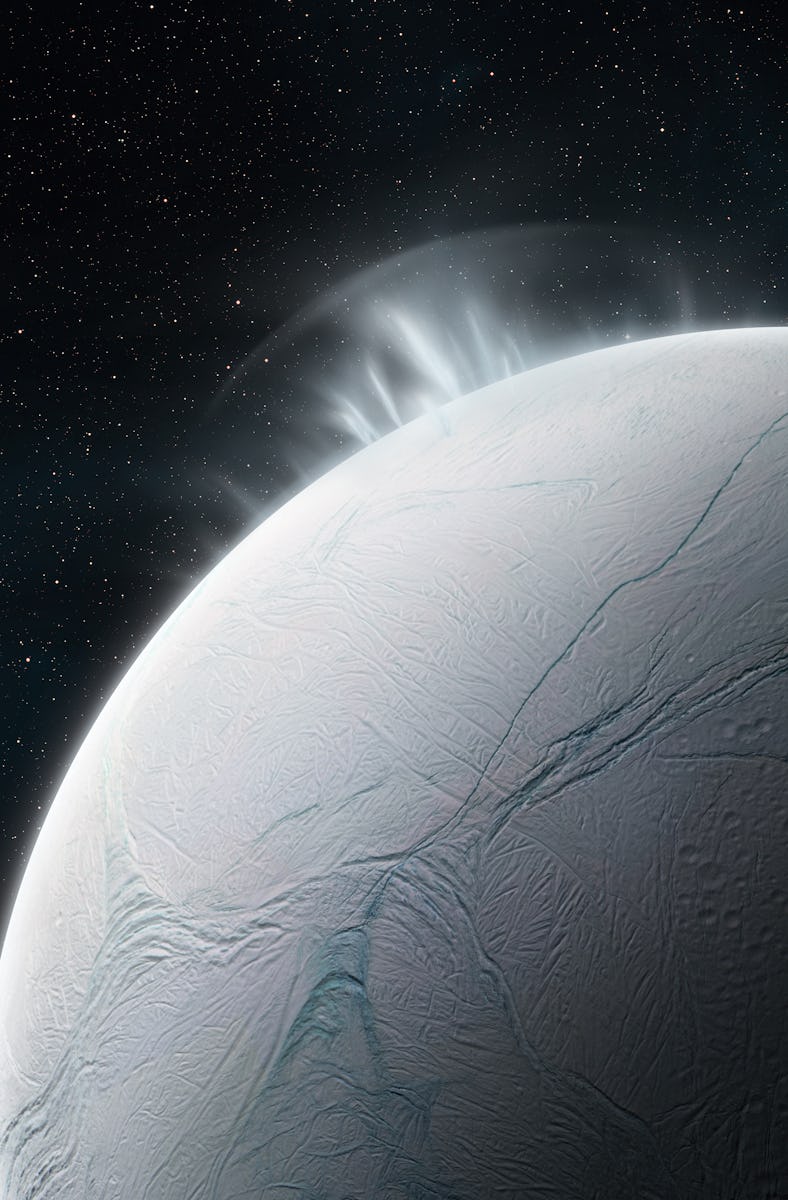Webb Telescope Spies a Huge Water Plume Coming from Saturn’s Most Intriguing Moon
Behold a spectacular geyser plume from Saturn’s icy moon Enceladus.

The James Webb Space Telescope (JWST) is revolutionizing what astronomers know about the Universe. Less than a year since debuting, JWST continues to pour in discoveries. On Monday, JWST officials published what it’s gleaned about a geyser spewing water at Saturn.
Some of the biggest secrets astronomers want to uncover are actually about our cosmic backyard. From JWST’s perch about one million miles from Earth, this $10 billion observatory is building upon the work of its spacecraft predecessors. In 2017, NASA’s Cassini spacecraft ended its whirlwind tour of Saturn and its moons, with an epic plunge into the ringed planet’s atmosphere, breaking apart and leaving behind an impressive scientific baton that has now passed to JWST.
Two images of Saturn’s moon Enceladus. The insert is an image from NASA’s Cassini probe. The larger blue image shows a geyser’s massive and fast-spraying plume. The larger image comes from the Near-Infrared Camera (NIRCam) onboard the NASA/European Space Agency/Canadian Space Agency’s James Webb Space Telescope. The blue shows a water vapor plume jetting from Enceladus’ south pole, extending out 40 times the size of the moon itself.
Cassini was the first to discover that one peculiar moon of Saturn, called Enceladus, has geysers. Enceladus is an icy place with a cracked surface that resembles tiger stripes. Somewhere below this frozen exterior, but above its hypothesized rocky core, Enceladus has salty water. This has led to speculation about a subsurface ocean and the possibility of alien life there. Cassini saw these fountains for itself, and actually flew through them.
More than half a decade later, JWST has observed Enceladus and spotted one impressive geyser. At JWST's distant vantage point, astronomers have gained a big-picture view about how this geyser affects the rest of the Saturn system.
There are three major components to JWST’s newest findings. First, the geyser’s plume is huge. “A water [vapor] plume from Saturn’s moon Enceladus spanning more than 9,600 [kilometers] — long enough to stretch across the Eurasian continent from Ireland to Japan — has been detected,” JWST officials wrote in a statement published Monday.
Saturn’s icy moon Enceladus orbits takes just 33 hours to orbit the planet. On the trip, Enceladus sprays water from its geysers, and leaves behind a torus — or “doughnut” — of material behind. The light blue ring at the top of this diagram depicts the torus.
Second, the geyser’s material is moving fast. “The rate at which the water [vapor] is gushing out, about 300 [liters] per second, is also particularly impressive. At this rate, you could fill an Olympic-sized swimming pool in just a couple of hours. In comparison, doing so with a garden hose on Earth would take more than 2 weeks,” JWST officials added.
Third, the spray is feeding a treat-shaped feature near one of Saturn’s rings.
“The Webb observations directly demonstrate how the moon’s water [vapor] plumes feed the torus, a fuzzy doughnut of water that is co-located with Saturn’s E-ring,” JWST officials wrote. About a third of the water stays there, and two-thirds supplies water to the rest of the Saturn system.
This work helps astronomers understand our local Universe, and the exoplanets being discovered around other stars.
This article was originally published on